MX3D Uses Robot Arm to 3D Print Robot Arm, Installs it on Robot
MX3D’s steel bridges are an inspiring sight to see, but, even if bridges are what the Dutch firm is known for, they are not the only thing the firm is capable of making. The company now has released a new 3D printed robot arm component made with its metal AM system, which relies on an industrial robotic arm of its own.
Made together with industrial automation company ABB and software simulation firm Altair, the new arm has been optimized by the Altair team working in conjunction with MX3D. Altair’s generative algorithms were not only used to cut part weight in half, but also to improve toolpath planning on the printer to increase the print speed. The total print time was four days and connecting surfaces were finished on a three-axis milling machine. The part has now been installed and is in use on an industrial robot.
 It is a good week for 3D printing bridges since we recently wrote about DSM’s polymer bridges. MX3D has been making WAAM printers relying on industrial robotic arms since around 2014 and we’ve kept you in the loop on its progress, use of machine learning, and projects involving Digital Twins for bridges and other large steel structures. Coupling finite element analysis (FEA) and the Digital Twin to manufacturing large-scale 3D printed parts is a key component of the DSM polymer bridges, MX3D’s metal bridges, and BAM’s concrete bridges. Indeed BAM’s concrete bridge factory is around the corner from Olivier van Herpt’s Eindhoven ceramics 3D printing lab with its ceramics and porcelain. One does get the feeling that it would be great if these four firms spoke with each other at one point, given that so many similar 3D printing initiatives are ongoing in the Netherlands.
It is a good week for 3D printing bridges since we recently wrote about DSM’s polymer bridges. MX3D has been making WAAM printers relying on industrial robotic arms since around 2014 and we’ve kept you in the loop on its progress, use of machine learning, and projects involving Digital Twins for bridges and other large steel structures. Coupling finite element analysis (FEA) and the Digital Twin to manufacturing large-scale 3D printed parts is a key component of the DSM polymer bridges, MX3D’s metal bridges, and BAM’s concrete bridges. Indeed BAM’s concrete bridge factory is around the corner from Olivier van Herpt’s Eindhoven ceramics 3D printing lab with its ceramics and porcelain. One does get the feeling that it would be great if these four firms spoke with each other at one point, given that so many similar 3D printing initiatives are ongoing in the Netherlands.
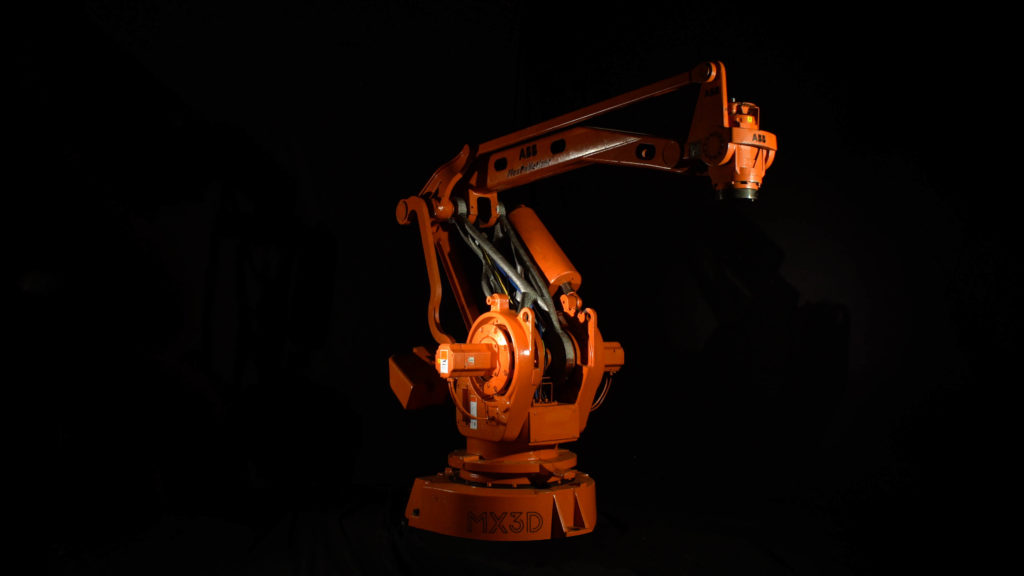
Are we seeing larger-scale 3D printing coming into its own? Firms are bridging the gap between the virtual and real-world through connecting data to optimized toolpaths, designs, and parts. Driven by resolution limitations, difficulties of working with industrial robots (lack of memory, proprietary syntax), and a strict regulatory environment large scale firms are turning to software to solve their problems.
We’re seeing a remarkable difference between the “house printing” companies—who seem, on the whole, to be rather optimistic and cavalier about their endeavors to print buildings—and the large scale part printing cohort of enterprises. The latter, which includes MX3D, seems much more in tune with regulatory requirements, certification, and software than the former. Perhaps, because you can’t really sell a bridge ex-works, while a demo house doesn’t have any regulatory requirements, so the parts builders have been put onto a more difficult digital path.
But, through controlling toolpaths, FEA, weight reduction, and using this as a tool to try to get parts built correctly, companies have been forced to deal with these things early on in their machine and process design stages. This, in turn, has led to them being better placed to build actual parts for the actual world. Meanwhile, the “housebuilders” are building much larger more media-savvy structures that have yet to be subject to many thoughts on how they will be built safely.
In 3D printing for construction, it would seem that the earlier on your business model encounters regulatory opposition, the earlier you will design safety, reliability, and repeatability into your process. Logical perhaps, but not something considered so far by the industry at large. One will expect however that the “go big or go home” crowd will seem to be ahead initially, but then take much longer to develop process control once they start building parts that will go on the open market and touch the realities of such arcane and frightening things, such as the law.
Whereas houses may be the best clickbait, there are myriad of other parts that can be built with robot arm construction systems through 3D printing. Generally, we can see that our market does nanoprinting on the submicron and micron-scale (femtoprint, nScrypt), microprinting on the mm to micron scale (3D Micro Print), regular 3D printing which starts from several mm parts to around 50 cm parts (RepRap, Ultimaker), medium format printing which is for parts of up to one cubic meter (BigRep, Builder), large format 3D printing for parts from one cubic meter to around ten cubic meters (CEAD, BAAM) and macro 3D printing which is parts that are larger than 10 cubic meters (3D Printhuset).
At each and every scale we can see a strange thing happening. Scale drives accuracy which drives value which, in turn, determines go-to market and that determines the level of quality leveled at the part. This is super logical in the sense that small things often have to be precise in order to exactly fit small assemblies, which in turn are likely to be a part of something complex that needs high tolerance—a watch, for example.
At the same time, if you can make things that are 1 mm x 1 mm or less, then a stent is something that you can do and you won’t think of car bumpers. Of the total set of things sold in the 1mm x 1mm x 1mm range, often a disproportionate number of these things actually have high value due to their precision manufacturing requirements.
This is, again, logical but could go against the conventional wisdom that more material equals more expensive production cost or the “rule of most things” that stipulates that larger things are typically bigger. In the mid-ranges, there also seems to be an ongoing effect whereby, if the things that you print are likely to be the same size as inexpensive manufactured goods but are more difficult to make, larger and smaller things can vary more widely in price. Production difficulty, in large or small structures, drives price and applications, as well. I’m not saying that size is solely deterministic, but we are seeing effects here.
On the micro- and nanoscale, quality systems are adopted rapidly by participants due to their adjacency to the medical business. If medical is the most profitable thing you can do and just about the only thing you can do, you’re going to end up having a cleanroom. Meanwhile, it took a long time for a lot of service bureaus to turn to ISO, and desktop machines are currently still sold with a warranty that scarcely lasts past the UPS carrier’s hands. Now increasingly, quality systems and certifications are being adopted by desktop companies and service bureaus. In larger-scale things, we’re seeing medium format start to look at quality now.
Many of us are familiar with the innovator’s dilemma, whereby a large volume good enough product displaces a better more expensive earlier one. Could we in 3D printing see a similar effect where higher quality systems engineered for smaller sizes could displace established entrants with larger sized parts? If Prusa and Ultimaker were good at precision in the 10-cm range, wouldn’t it be fairly easy for them to scale their systems on the back of their existing installed base?
Crucially, they wouldn’t have to adapt all systems completely, but just make some components stronger to reach the next size of medium-format machines. If they jumped to the Cincinnati BAAM category, of course then they’d have to completely re-engineer everything, but the adjacent category would be simple for them to do. But, for them to work at the microscale would mean a lot of adjustments to their current design and manufacturing of hardware components as well as working in a higher quality standards way.
This leap would be daunting, especially since the volume of products made with the smaller category would be less than with their own. Furthermore, they could expect to sell less material and fewer machines in the smaller size category, but more material and fewer machines in the one-size larger category. Especially consumables driven firms or companies such as polymer firms will benefit from more parts, faster print speeds and larger sized parts. The sum total of these effects could indicate pressure on firms to move into larger scaled manufacturing all the time, but ignore smaller scales.
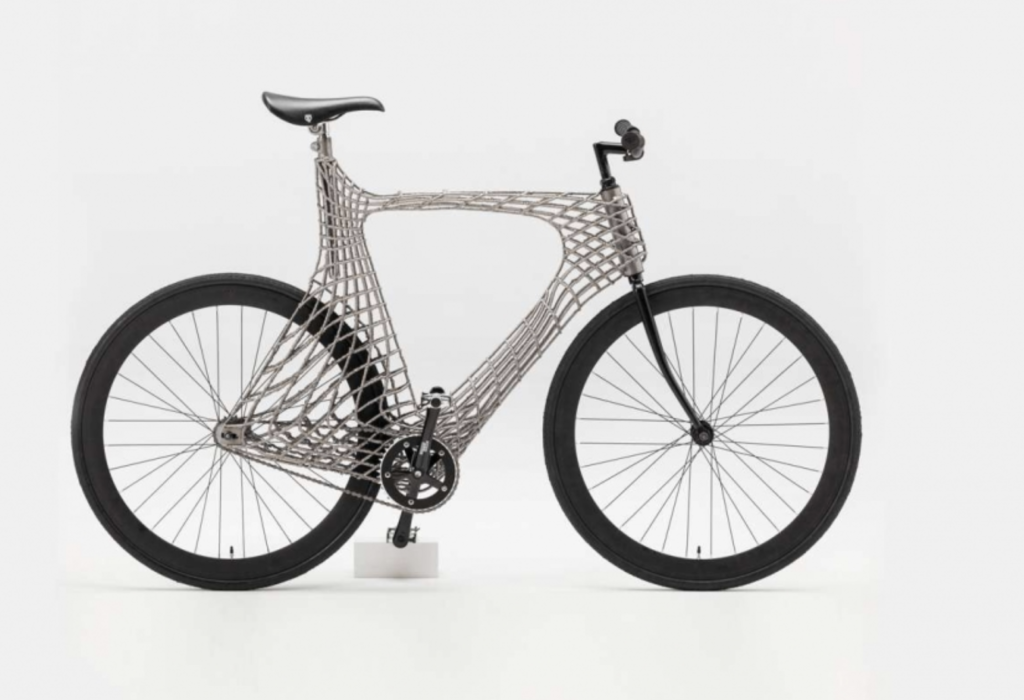
If we look at MX3D for example, we may think of its bridges which it may sell in the hundreds if it got them right and could certify them. But, MX3D also can sell many more smaller components at larger volumes as well. Its Takenaka connector for example needs precision, but this component could sell in its thousands. Bike frames need to fit with precision components, such as derailleurs, and the precision and volume required for these components can drive its other businesses. Operational advantages gained here could be used to earn margin on larger components, such as bridges, that few can make. It seems blindingly obvious if we compare it to bicycle companies moving to passenger cars and then sometimes to vans and sometimes to trucks. This development seems to be a very similar one.
If this holds true, then for MX3D, the future could be in making many medium-sized parts for a larger scale future. In Dutch we have an expression, “wie het kleine niet eert, is het grote niet weed”, which means, “he who does not honor the small things does not deserve the large.” For 3D printing, this expression may hold very true indeed.
The post MX3D Uses Robot Arm to 3D Print Robot Arm, Installs it on Robot appeared first on 3DPrint.com | The Voice of 3D Printing / Additive Manufacturing.
MX3D gains interest of construction sector following ambitious 3D printed bridge
MX3D releases updated Arc Bike II 3D printed from titanium
University of Sheffield joins €17 million INTEGRADDE project to accelerate industrial additive manufacturing
Huisman installs first 3D printed crane hook on offshore vessel
Shanghai Mechanized Construction and Polymaker 3D print a pedestrian bridge
MX3D Metal 3D Printed Bridge on Display in Eindhoven During Dutch Design Week
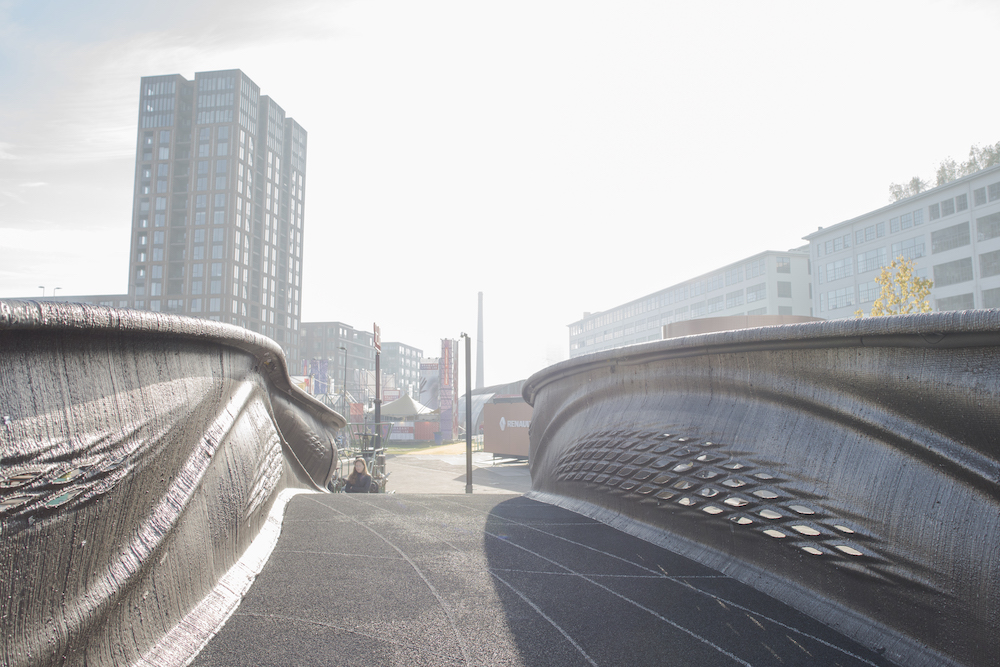
MX3D has been working for a number of years on a metal printing technology specifically for bridges and large metal items. Incorporating machine learning and AI into the build process the company uses robot arms to layer by layer deposit metal. The company is using off the shelf robots and welding technology in combination and they can deposit over one Kilogram per hour per robot arm. By using six axis robots they tout their degrees of freedom they will have with these robots but they could potentially not be accurate (stiff as well as positioning accuracy) enough to give really stellar results.
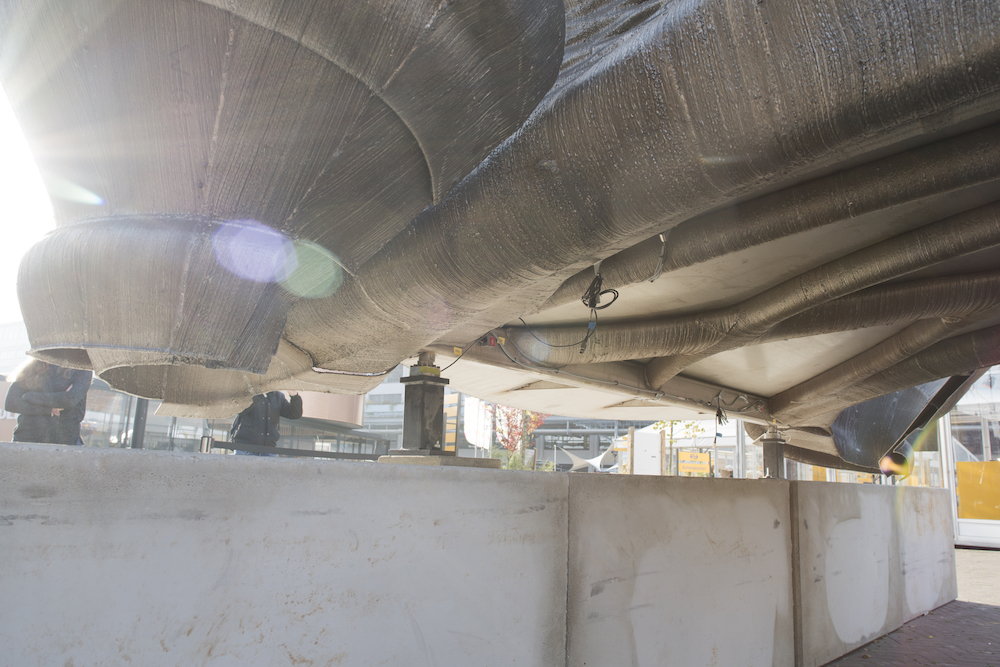
What is very interesting is that they say that their printers are significantly cheaper and that they also use steels that are $5 per kilo. Started by Joris Laarman and supported by Autodesk MX3D is a very interesting technology for large outdoor objects. I really like it as a technology for printing rebar like structures for reinforced concrete and think that this is a great application for it. In addition to Autodesk, the company also works with Lenovo, Arcelor Mittal, ABB, Air Liquide and Arup the engineering company that makes starchitect’s dreams come true. Especially that partnership and the one with ABB who are giants in robot arms and other industrial automation give MX3D a real leg up on the competition. Dutch Design Week is one of the largest design events in the world, taking place every year in Eindhoven it has over 300,000 visitors attending the hundreds of design events and showcases each year.
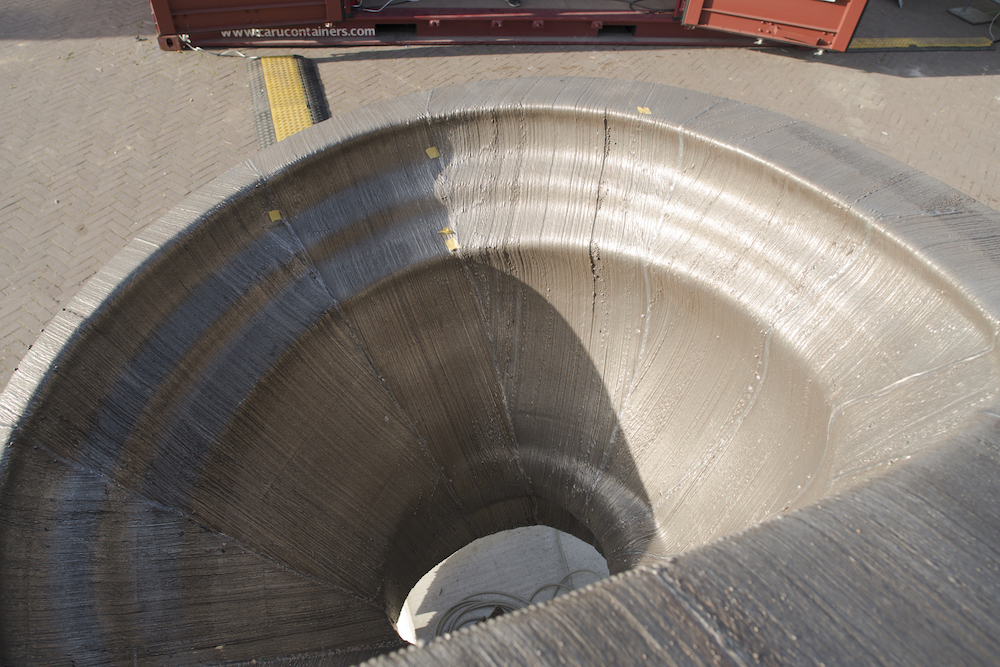
MX3D today has showcased its bridge on the Ketelhuisplein in Eindhoven so people can see the future of construction up close. It is not huge but it is very impressive. Competition in house and outdoor printing will be heating up over the next few years. Many more players want large-scale objects that are not viable with current industries. Especially in shipbuilding, industry, construction and oil and gas, this is a wish. Few 3D printing technologies are designed to be economical as well and this will greatly increase application areas for this technology. For large scale printing, the most players either seem to be focussed on polymers, metal welding or concrete.

The problem with the polymers is shrinkage, lack of control, rough and ugly objects and reinforcement. Essentially they’re using off the shelf materials to try to make outdoor structures which is silly. Instead they need to make materials specifically for outdoor 3D printing applications. In that way, they can insulate, build faster and build more functional objects. In welding process control is a real problem and objects are barely held together cheez whiz metal kinds of things.

Better closed loop type things and advances in machine vision and controlled cooling need to happen here. In concrete 3D printing, there are more liars than actual practitioners and we will need to lose the tricksters for that market to advance. Apart from that lack of good layer adhesion is an issue here. If this is the year of metal printing can 2020 be the year of large-scale printing?

